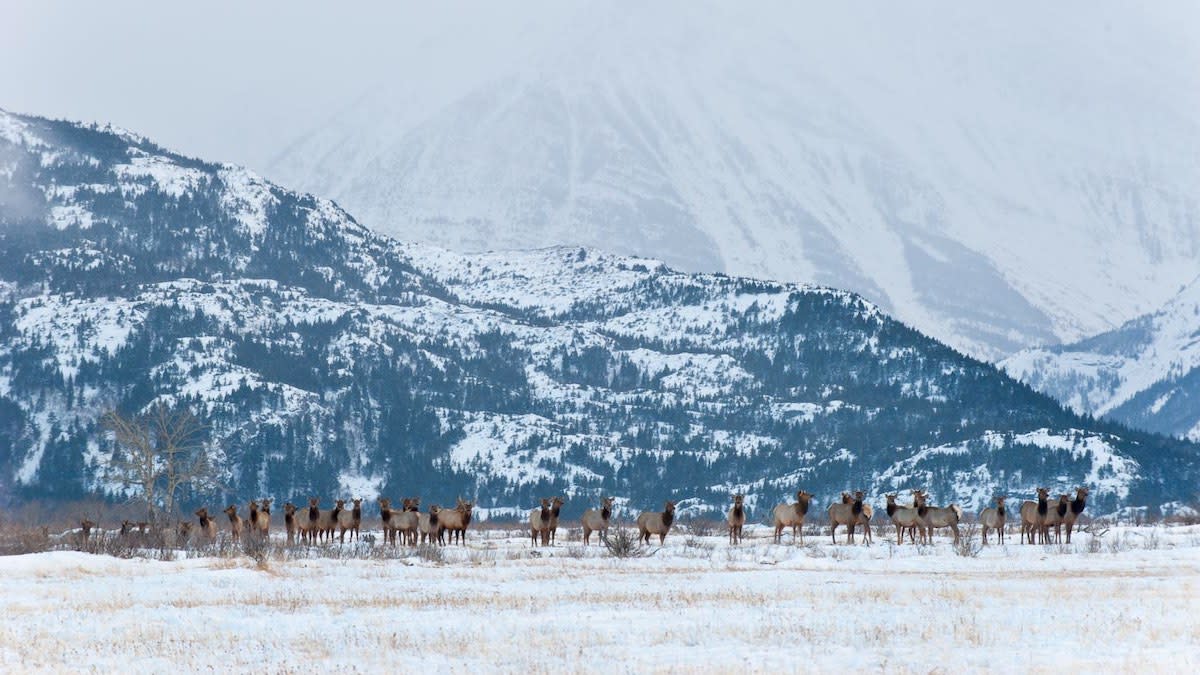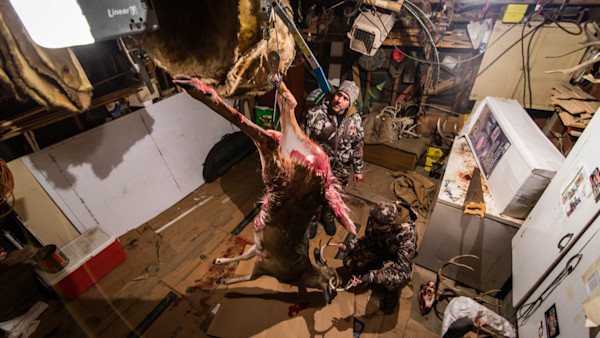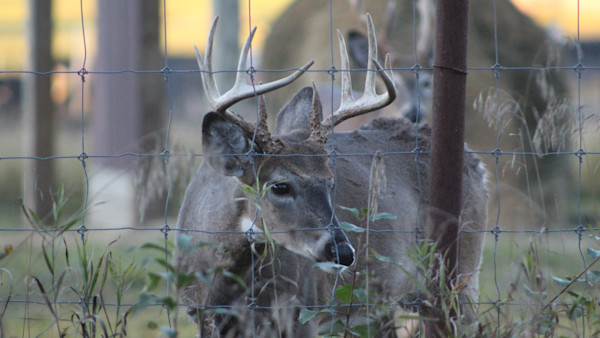
I grew up in Pinedale, Wyoming, and the Upper Green River has always been a sacred place to me. It’s where I learned to row a drift boat and caught my first fish on a dry fly, and the magic doesn’t stop in the winter. Riding a snowmachine through hundreds of elk on the way to ice fish with Square Top Mountain looming in the background is a surreal experience. Being surrounded by numerous, massive bulls over a 20 acre spread as they lazily eye your sled is bizarre. However, with a closer look, they act more like livestock than wildlife. Sure, a few younger bulls might be practicing for the rut, but most of the elk are lounging around or munching on whatever remnants of hay lay on the ground from the morning feeding. But there is no such thing as free lunch, not even for these apparently content feedground elk.
Don’t Feed the Wildlife…Right?
The Upper Green Feedground is one of 22 such locations in Western Wyoming. According to the Wyoming Game and Fish Department, feedgrounds began in 1912 after a few really severe winters saw thousands of elk die from starvation. Feeding elk at that time was a logical move because development and ranching disrupted elk from reaching their historic, critical winter ranges. Today, feedgrounds still provide food sources through the winter, reduce human-elk interactions, take pressure off other big game animal’s critical winter ranges, and keep elk out of rancher’s hay and away from their cattle. However, these feedgrounds may be causing more problems than they’re solving.
According to MeatEater Conservation Director Ryan Callaghan, “the history of feeding programs for elk and deer in the West is one that was meant to end. No Western rancher with a soft spot for dwindling elk populations ever imagined the feeding of elk in perpetuity.”
The primary reason that some feedgrounds like the National Elk Refuge in Jackson have stuck around for so long is tourism. Taking a sleigh ride through a herd might be an appealing winter activity, but it can reinforce anthropomorphic ideas about elk and an assumed dependency on humans for their survival.
There are some serious downsides to feedgrounds. They’re expensive. The annual budget for feedgrounds is $1.6 million and even though hunters in these areas have to buy a $15 Elk Special Management Permit, this only offsets the cost by about $160,000. It’s not cheap to feed 20,000 elk every day through a Wyoming winter. More worrisome, however, is the elk herds’ population density. Feedlots force large numbers of elk into very close quarters, which aids in the transmission of density-dependent diseases.
Ailments currently plaguing feedgrounds include: scabies, which typically affects stressed animals like bulls after the rut; brucellosis, which directly impacts pregnant cows; and necrobacillosis, which targets calves. Chronic wasting disease has the potential to infect an entire herd. Although scabies and necrobacillosis are serious diseases to manage, brucellosis has been a major point of public concern for the past couple decades, largely because the disease is transmissible between elk and cattle. As CWD becomes more prominent in Wyoming, criticism of feedgrounds is growing.
Brucellosis
The bacterium Brucella abortus causes the disease brucellosis. The infection causes abortions and infertility in cow elk and cattle alike. This interactive map depicts brucellosis dispersal across the state. In the past decade, two programs to manage the disease by the WGFD have been tested on feedgrounds. The test-and-slaughter campaign was proven successful in lowering prevalence of the disease in herds, but was cost and labor inefficient. Vaccinations (which proved successful on cattle) have been delivered to elk through a .25 caliber air rifle and although 99% of calves were vaccinated, the program proved ineffective overall on elk.
Brucellosis is a low risk disease for hunters because the bacteria is not “active” until around Feb. 1 (a reason elk hunting season ends Jan. 31). The bacteria is not typically found in meat but exists in the fetus and its associated fluids as well as in joints and lymph nodes of adult elk. Additionally, the bacteria will die with normal cooking temperatures, so a brucellosis positive elk is safe for human consumption. Brucellosis, however detrimental it can be to a herd, has proven relatively manageable compared to the havoc CWD promises.
CWD
CWD is a progressive, fatal, and untreatable disease caused by prions—infectious, misfolded proteins that are incredibly difficult to destroy. Although an animal can be infected for up to 18 months, it won’t show symptoms until the last four to eight weeks. However, the animal is shedding prions during the entire incubation period through feces, urine, and saliva. This shedding places the prions into the environment where they can survive for as long as 16 years in soil and plants and infect other animals through grazing. These factors make controlling CWD extremely difficult. It has spread across North America and beyond since its discovery in Colorado in 1967.
As MeatEater friend and contributor Doug Duren has stressed, “CWD is one of the biggest conservation challenges of our lifetime.”
The ability for these prions to be easily passed between animals and exist for years in their environment solidifies just how destructive CWD could be to feedground elk. Minnesota and many other states face a similar problem with CWD and deer farms. Although there is no evidence that prions can be passed to humans from infected animals, the Centers for Disease Control recommends not eating meat from animals that have been infected.
CWD has existed in the Eastern Wyoming Laramie Peak Herd for a couple decades, but Western Wyoming has avoided the disease in elk until very recently. A hunter-harvested cow elk was confirmed to be CWD positive Dec. 16, 2020. It was killed in Area 67, just north of all 22 feedgrounds. This interactive map depicts where CWD has been found across the state in specific hunt areas for elk, deer, and moose.
What Now, Wyoming?
The WGFD website states: “the department is not considering feedground closures in the short and mid-term, and intends to support the Western Wyoming practice that has been in place for over 100 years.” WGFD recently held an online question and answer session regarding feedgrounds, held both to inform user groups and gather public opinion. It is important to note this session was merely an initiation of a multi-phased process in elk feedground management.
The first question was asked by local rancher, Brian Cook. “Is there ever a chance we’re going to get the Alkali Feedground up and running again?”
Alkali is a smaller, 91-acre feedground located near the National Elk Refuge in the Gros Ventre Range. This feedground was selected to enter a five-year phase-out plan starting in 2019. Fewer elk had been feeding there, making it an ideal location to see what happens when you stop putting out hay for elk. After explaining the plan, Brad Hovinga, regional wildlife supervisor for the Jackson area, replied that “it’s not likely that we’ll continue to feed there, but we don’t really need to.”
Cook disagreed because, without the Alkali Feedground, he is now dealing with elk grazing on his ranch.
It’s undeniable that cattle are iconic of the West, a large part of Wyoming’s economy, and many folks’ way of life. But the same can be said of wildlife. Imagine if CWD becomes widespread on the elk refuge—I don’t think tourists will be taking sleigh rides to see a herd of droopy-eared, drooling, dying elk. But if we do stop feeding elk, will we see hundreds, if not thousands of emaciated, starving animals during winter months? Perhaps, but a herd is able to build itself back up from a rough winter. CWD persists in the environment so its impacts can be long lasting.
The Teton County Commissioners are voicing their concerns regarding CWD. They drafted a letter to WGFD addressing the issue of disease on feedgrounds, claiming, “CWD cannot be ignored nor can the threats to winter elk mortality and agricultural operations posed by the potential changes and reductions in the use of feedgrounds. Yet actions must be swift. And the time to act is now.”
Montana’s game commission is also concerned with Wyoming’s approach to this issue. “Montana’s ability to combat CWD will depend upon decisions that Wyoming makes about its wildlife management. As a commission, we believe that we cannot successfully address CWD without Wyoming’s help. As your neighbor, we ask you to begin the process of closing these feedgrounds.”
Ryan Callaghan pointed out that it was once common practice to feed bears garbage. In fact, up until WWII, Yellowstone had a “Lunch Counter—For Bears Only,” a really simple way to deal with trash in the park while providing a tourist attraction. Obviously, things have changed. Now it’s mandatory to hang your food or use bear-proof containers whenever you’re in bear country because everyone knows: a fed bear is a dead bear. Many people are wondering if it’s time for elk to be weaned off the feedground teat. Is a fed elk a dead elk? Not yet necessarily, but it could be a sentencing.
Featured image via Tony Bynum.
Related







Conversation